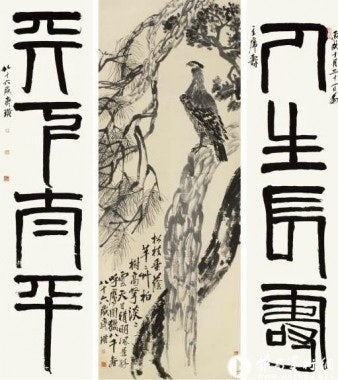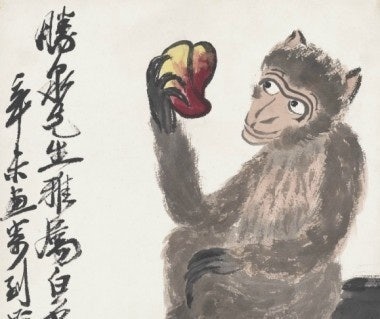Qi Outsold Andy Warhol In 2010, Making Him World's #2 Top-Selling Painter That Year After Picasso#

"A Long Life, a Peaceful World" by Qi Baishi sold this weekend for US$65 million
He may not be a household name in Western countries, but over the past few years the Chinese painter Qi Baishi (齐白石, 1864-1957) has quietly emerged as one of the world's top-selling artists on the strength of his popularity among cashed-up mainland Chinese collectors. As the global financial crisis hit international auction houses in 2009, emergent Chinese collectors pumped millions into works by Qi at domestic Chinese auctions, making his ascent appear even more dramatic, and following two years of strong sales, last year Qi Baishi trailed only Pablo Picasso in ArtPrice's annual artist sales ranking with US$70 million in sales. This saw Qi, for the first time, surpass list stalwart Andy Warhol, an achievement that was not lost on the international art press.
Now, in the wake of this weekend's China Guardian spring auctions in Beijing, held this past weekend, Qi is back in the news. On Sunday, Qi's 1946 ink painting "A Long Life, a Peaceful World" sold for a jaw-dropping 425.5 million yuan (US$65 million), in the process setting a new record for a Chinese painting. The 100 x 266 cm (3 x 8.5 feet) ink wash, originally created as a gift to then-Chinese leader Chiang Kai-shek, depicts a falcon on a pine branch, flanked on either side by Qi's masterful calligraphy. The sale of this work, along with another of Qi's paintings that sold for 92 million yuan (US$14 million) this weekend, helped the China Guardian spring auctions pull in a grand total of 1 billion yuan ($649 million) so far.
As Artinfo points out, on the strength of its ongoing spring auctions, China Guardian looks to reassert dominance in the domestic Chinese auction house over its rival Poly, which edged the former out last year with US$1.5 billion in sales last year. With the priority these auction houses place on traditional Chinese artists (though they are increasingly championing contemporary Chinese artists as well), Artinfo notes that China Guardian and Poly are hoping to tap an increasingly important market:
Over the last couple of years, as Chinese collectors have increasingly made their presence felt in auction rooms around the world, the value of works by modern masters like Qi Baishi, Xu Beihong, Zhang Daqian, and Fu Baoshi have skyrocketed. Last year these modern artists, whose work is in the traditional Chinese style, took out four of the top ten spots in Artprice's global rankings by auction revenue.
The previous record for a Chinese painting at auction was set last year at Beijing's Hanhai auction house, when Xu Beihong's "Ba People Fetching Water" (1937) sold for for RMB 171 million ($25.8 million). Qi Baishi's work now takes third place overall in the record rankings of Chinese works of art at auction. First place is held by the Qianlong vase that sold at Bainbridges in the United Kingdom for $85.9 million last November, with second place going to a calligraphy by Song Dynasty master Huang Tingjian that sold at Poly Auctions in Beijing last June for RMB 436.8 million ($64 million).

Qi Baishi's "Monkey Contemplating Peach" (Detail) is estimated to sell for $193,830 - $258,440 in Hong Kong next weekend (Image: Christie's)
Basing projections on the strong sales seen at China Guardian's weekend auctions, what can Qi Baishi's $65 million painting mean for the upcoming Christie's spring auctions in Hong Kong? As Guo Tong, general manger of contemporary and modern Chinese painting and calligraphy at China Guardian, said after the sale in Beijing, "Qi Baishi is the most influential artist in China's contemporary and modern art history. This work, with its high price, marks a new era for the market of contemporary and modern Chinese artworks." But clearly Qi isn't the only artist sought after by China's budding collector class. At Christie's in Hong Kong, along with watches, wine and jewelry, expect to see strong sales for not only traditional works by the likes of Qi, Fu Baoshi and Lin Fengmian but also contemporary painters like Zeng Fanzhi and Fang Lijun, artists who have proven highly popular with Chinese collectors.
Still, the fact that 31 Qi Baishi paintings will go under the hammer at the Fine Chinese Modern Paintings auction on May 31 in Hong Kong bodes well for the auction series' grand total. With low estimates ranging as low as HK$80,000 (US$10,338) and high estimates as high as HK$4 million (US$516,881) -- estimates that will likely mean little to motivated buyers -- the momentum seen in the Qi Baishi collector market could make him a mainstay on lists like the ArtPrice ranking for years to come.
But the increasing scarcity of his works, which will undoubtedly become an issue for collectors despite Qi's prolific output, will likely boost other big names like Zhang Daqian (1899-1983), Wu Guanzhong (1919-2010), and Xu Beihong (1895-1953).